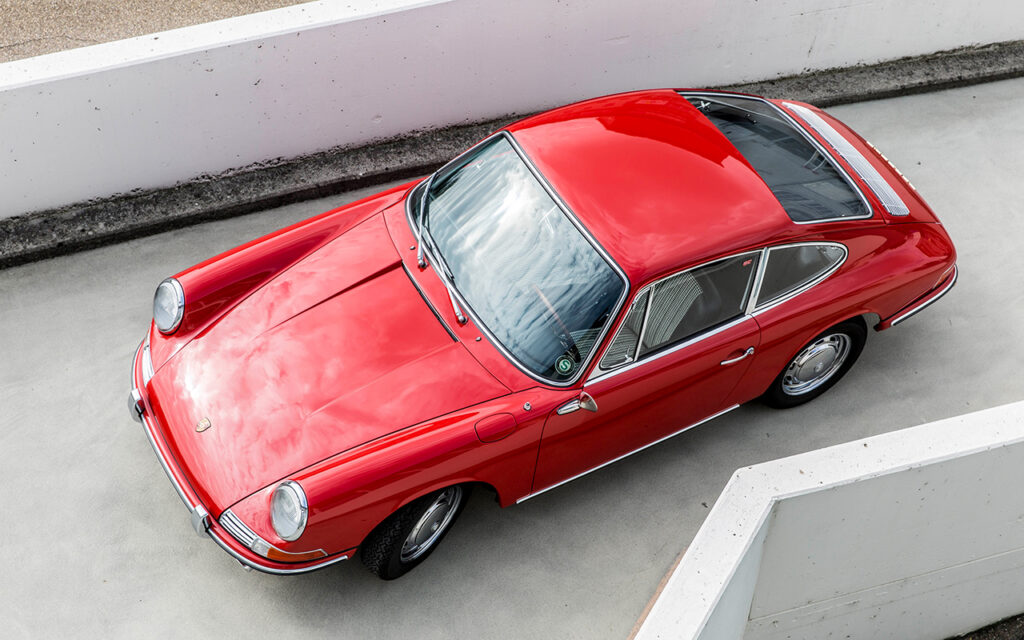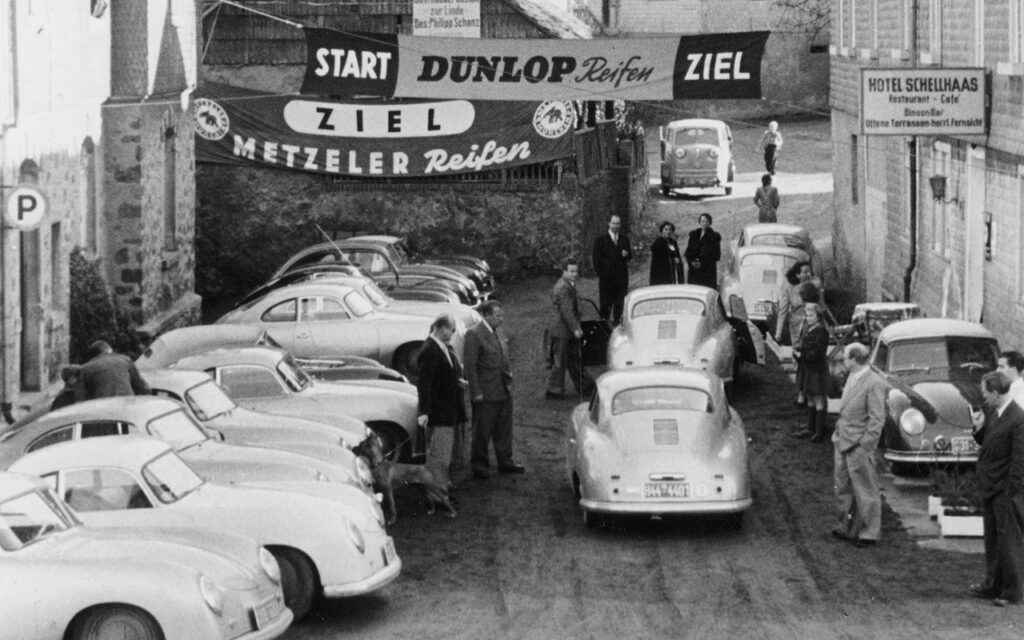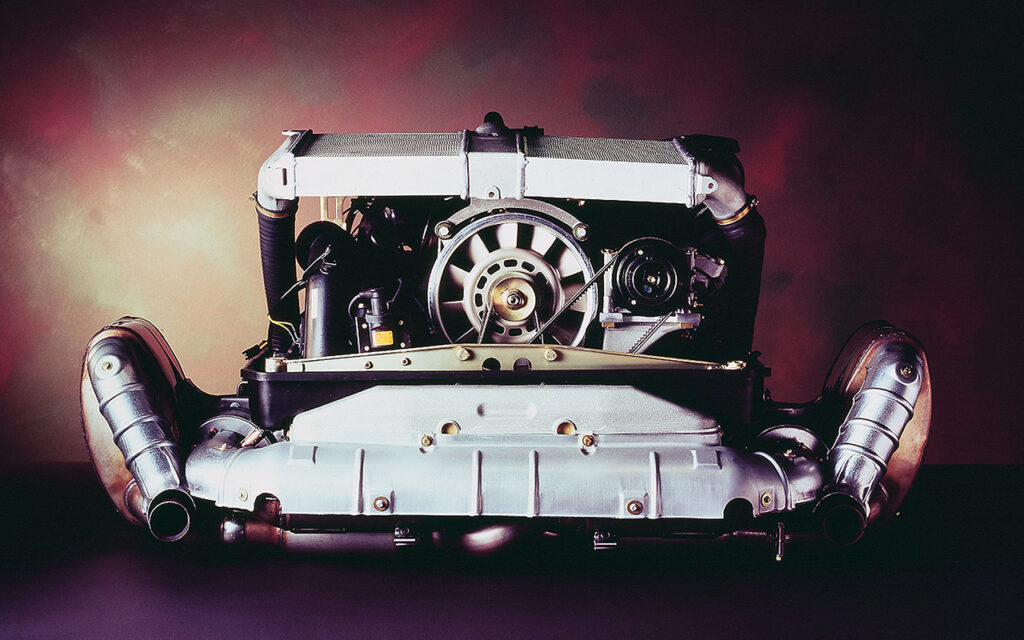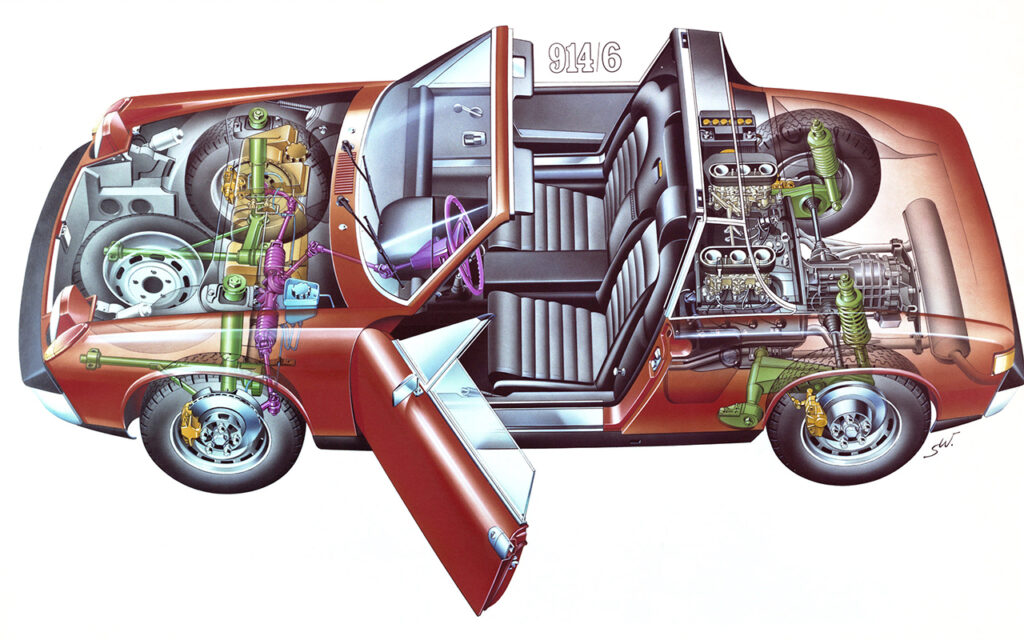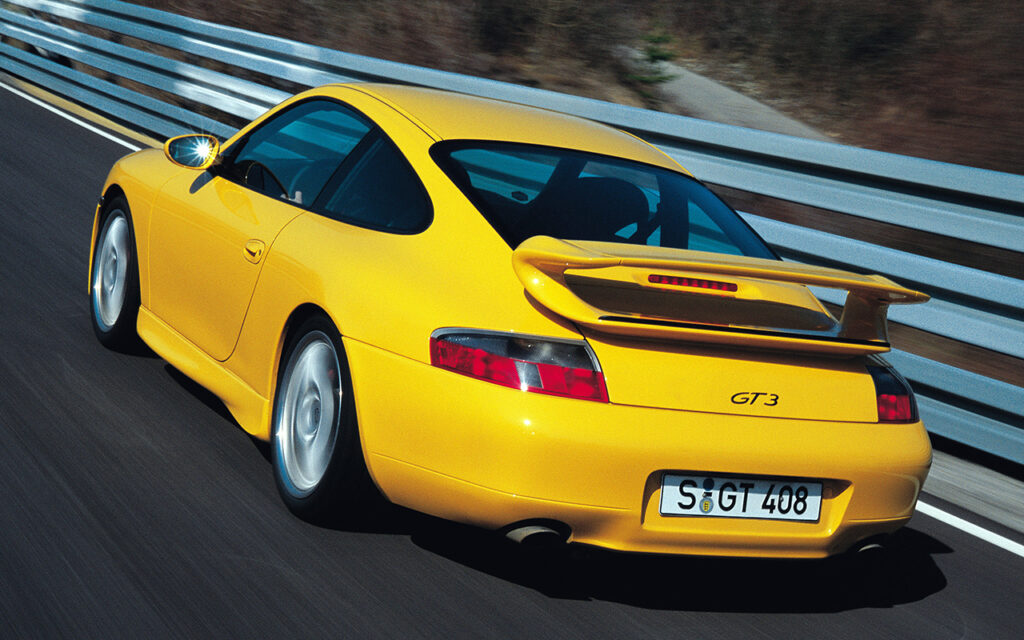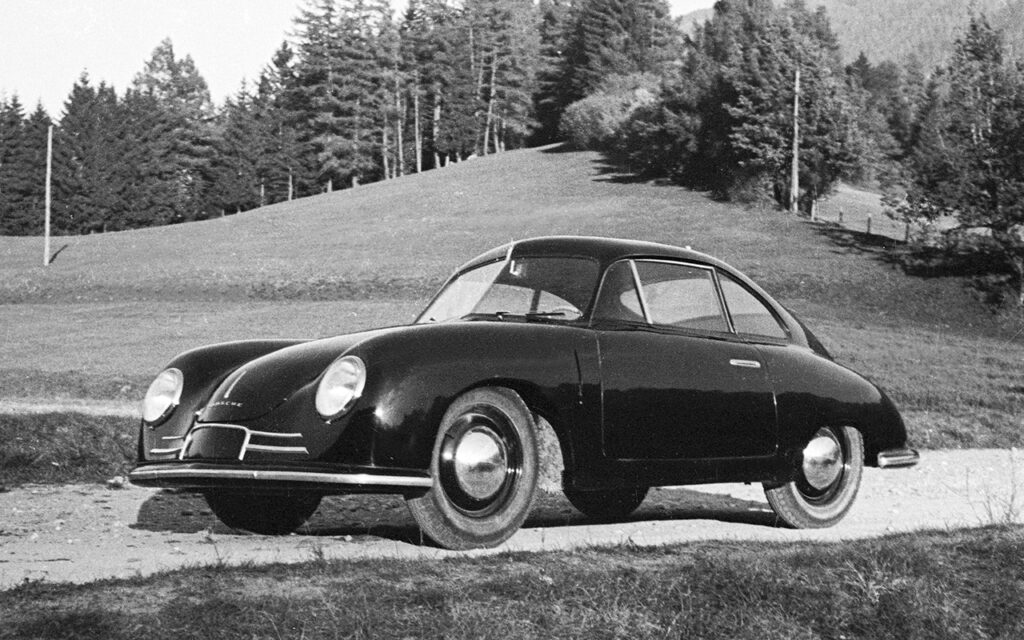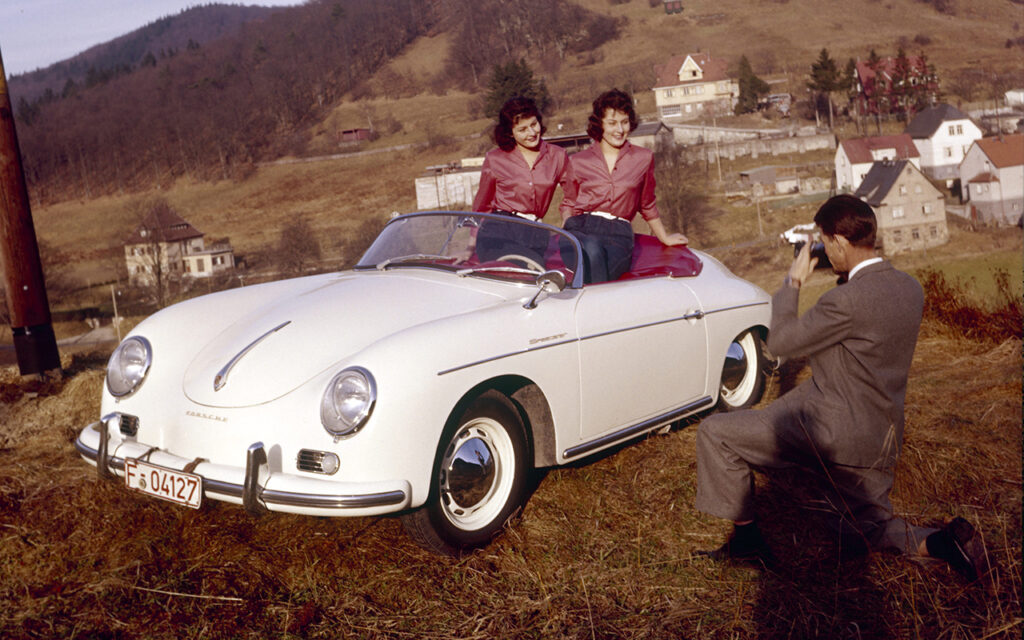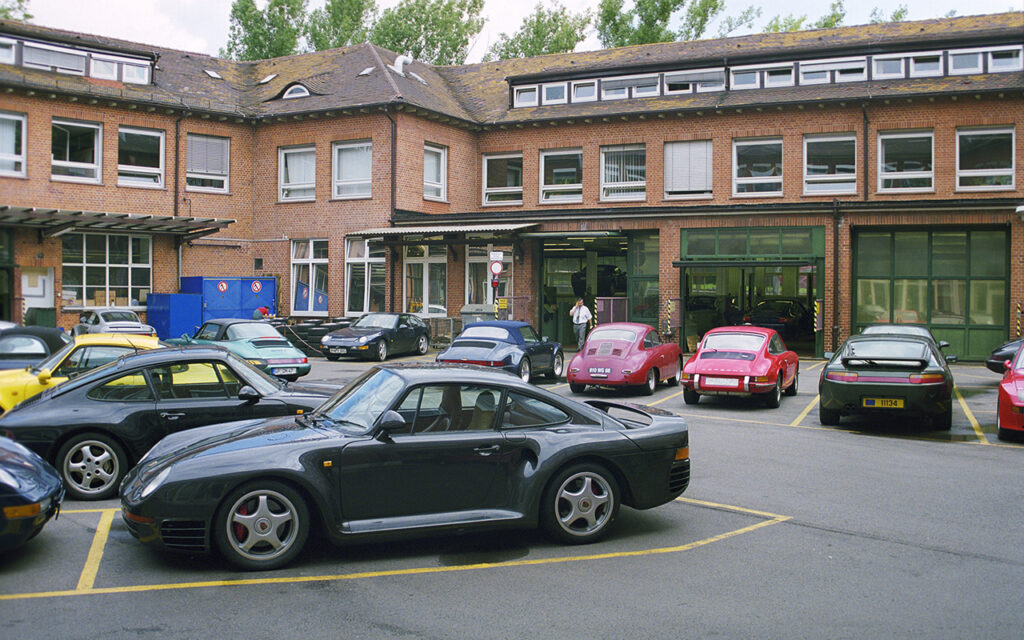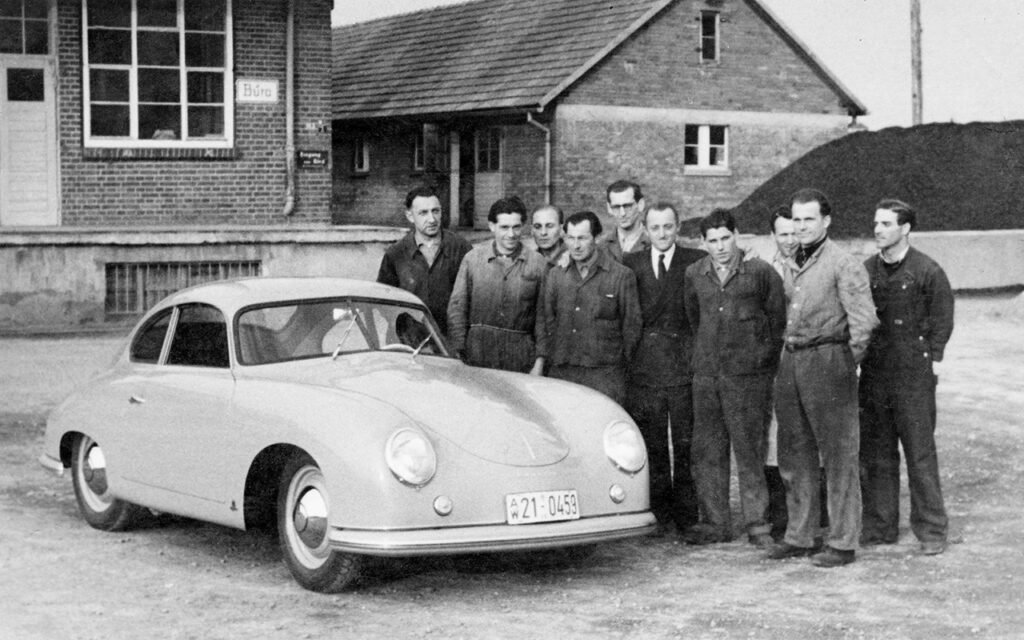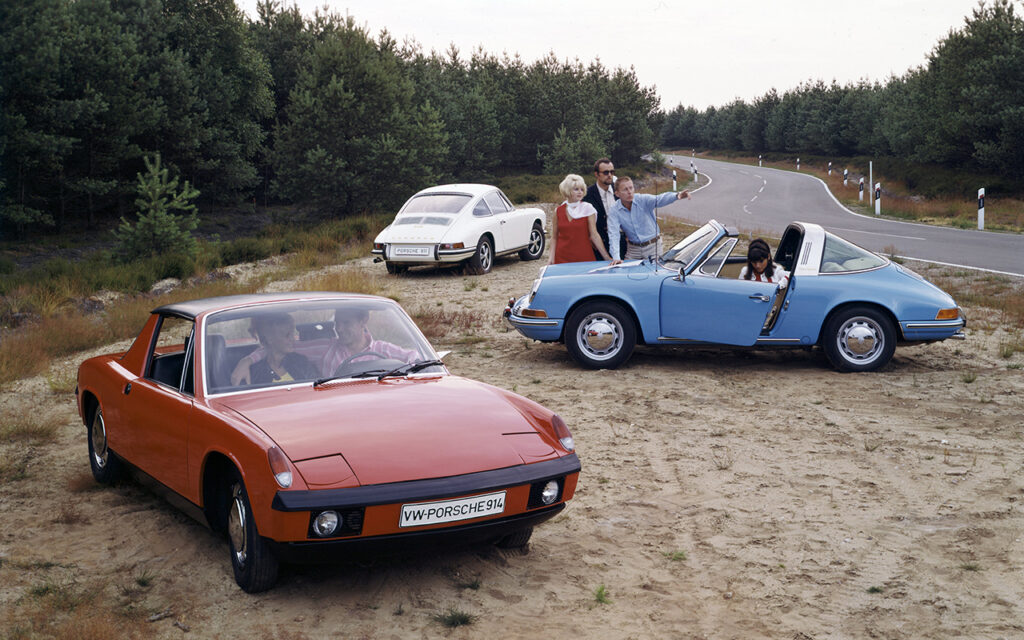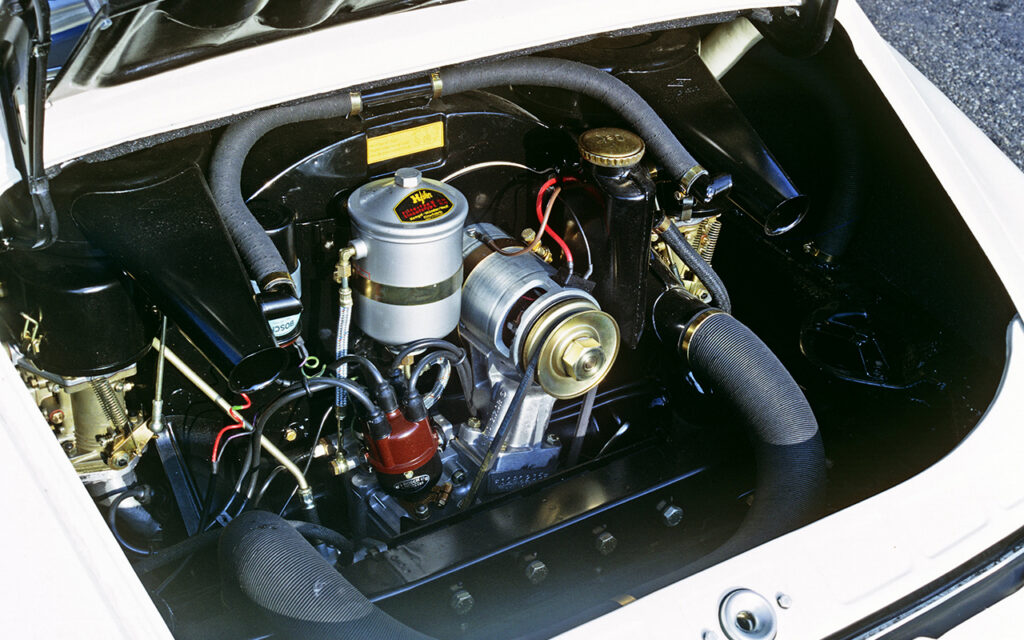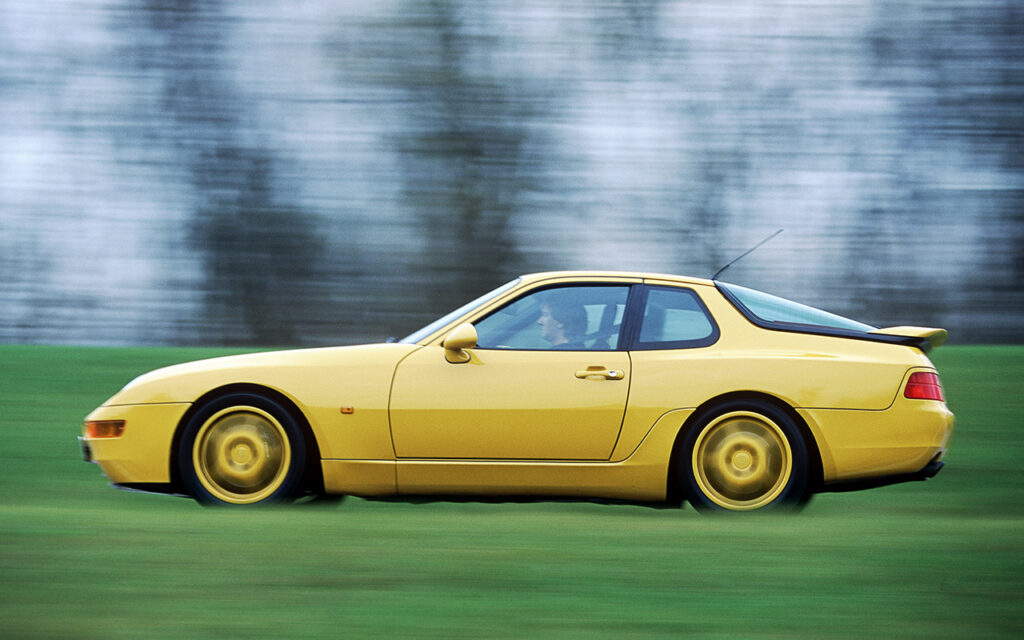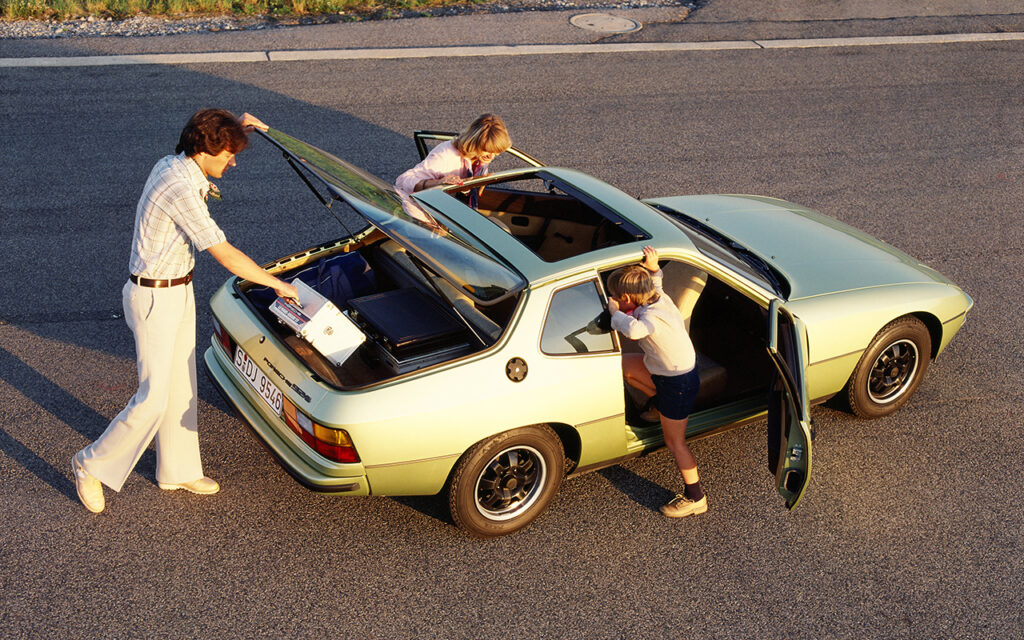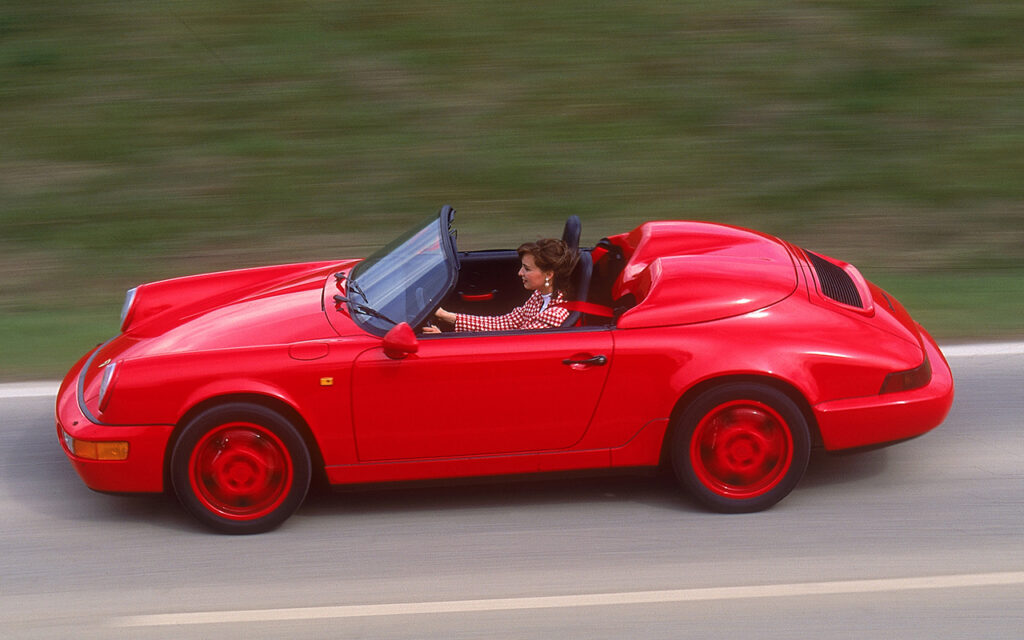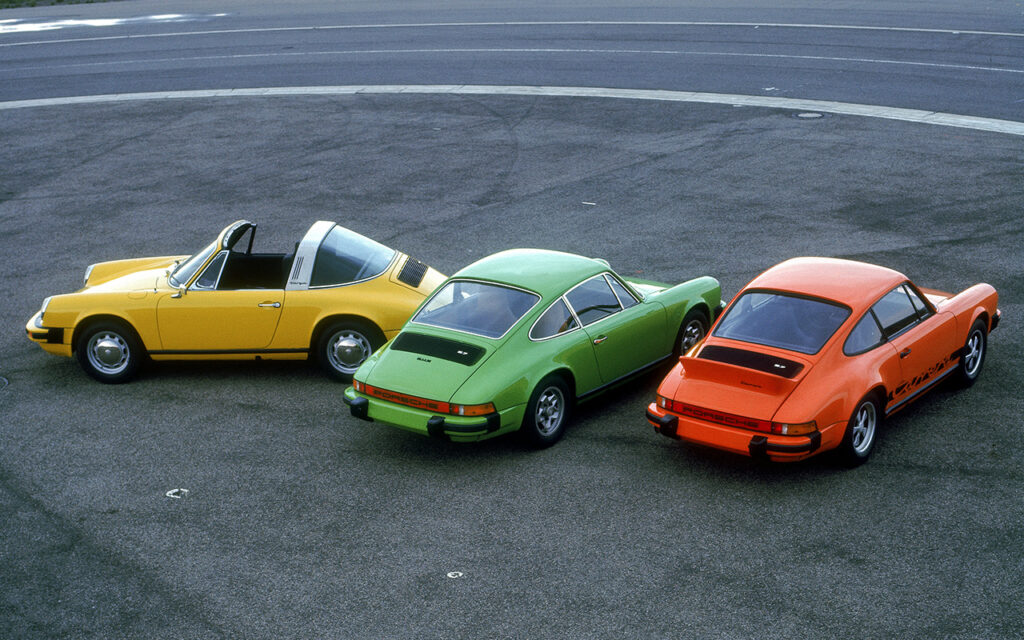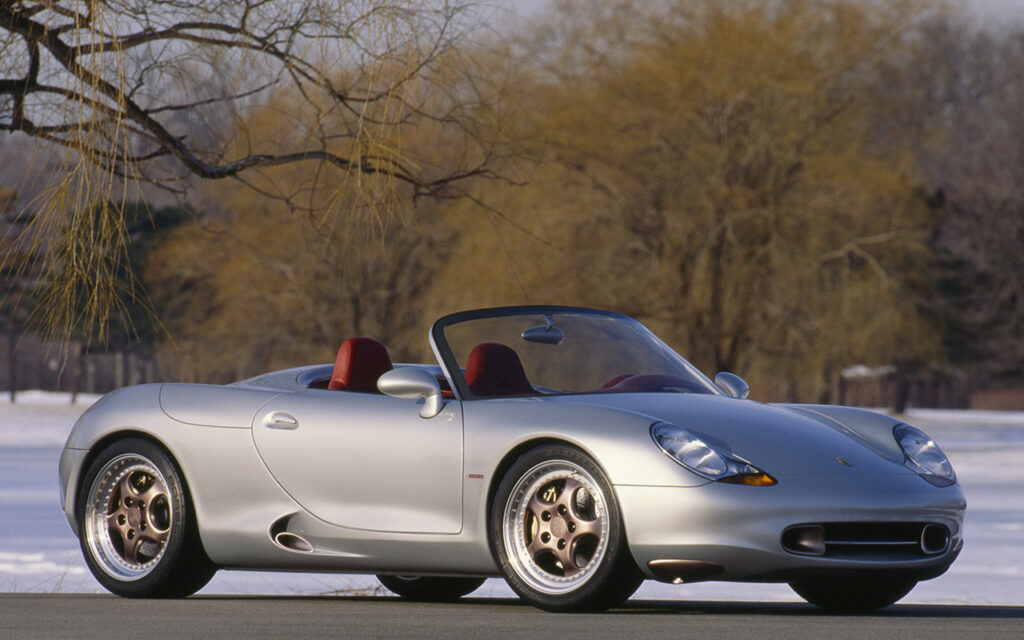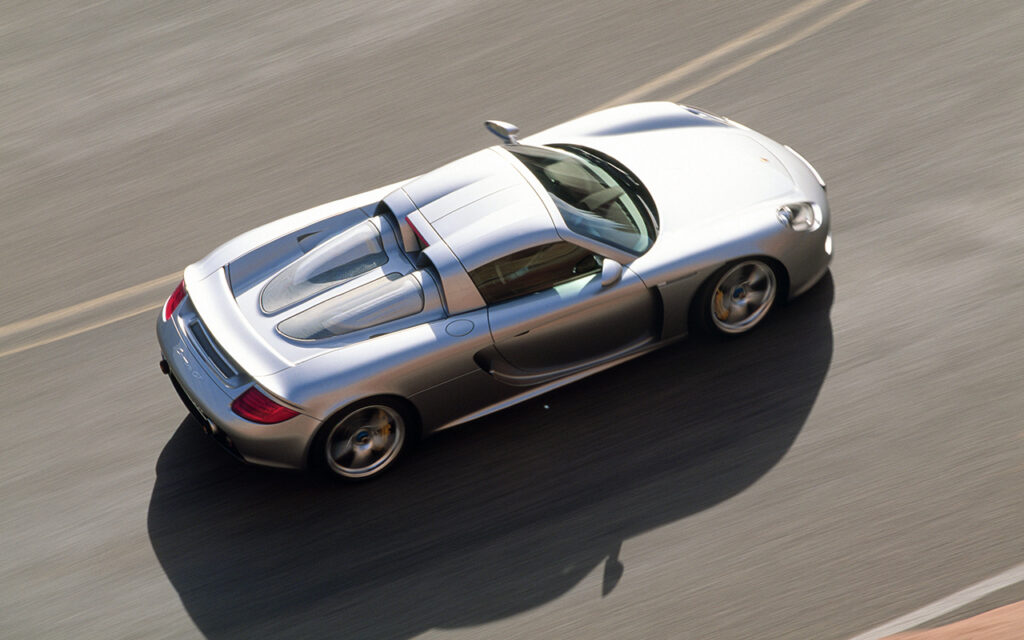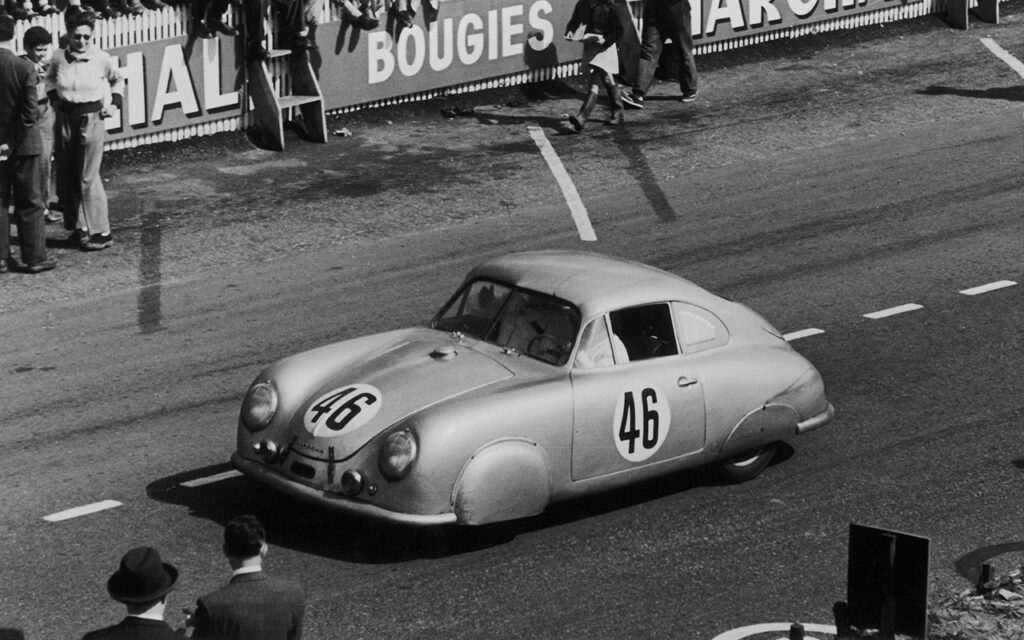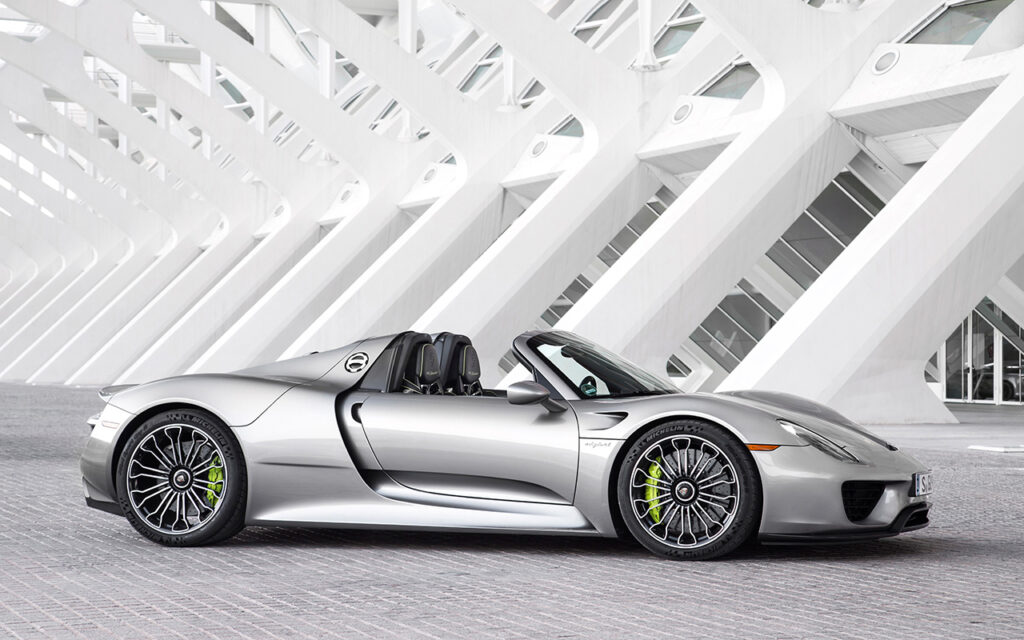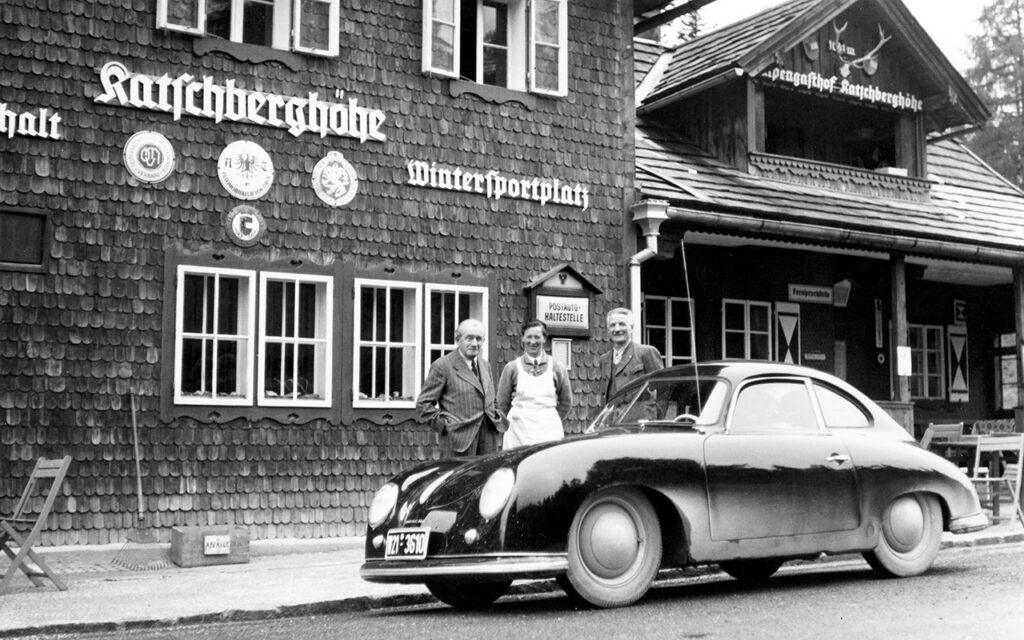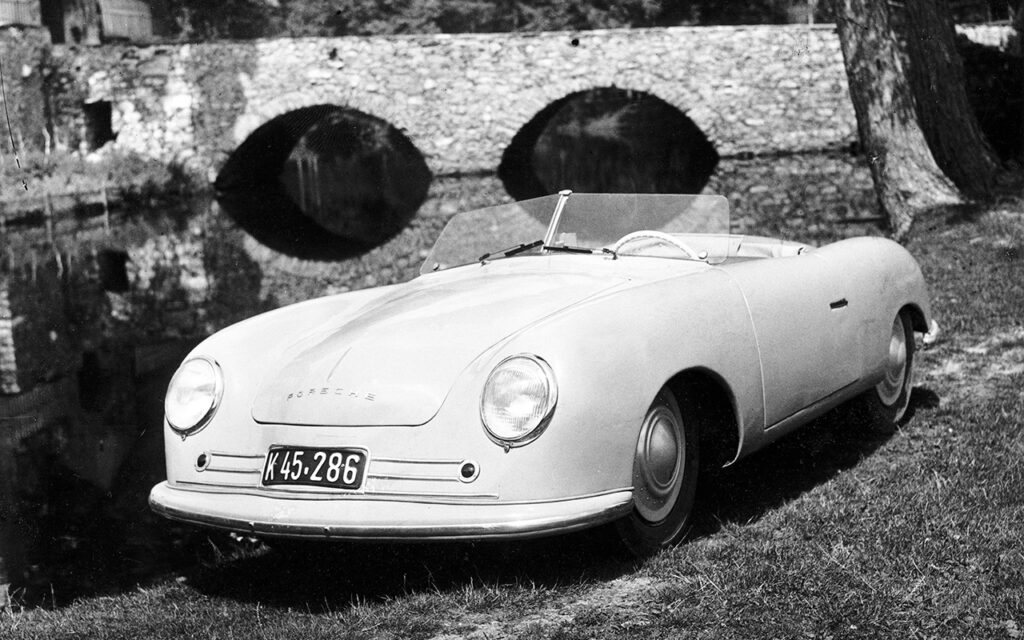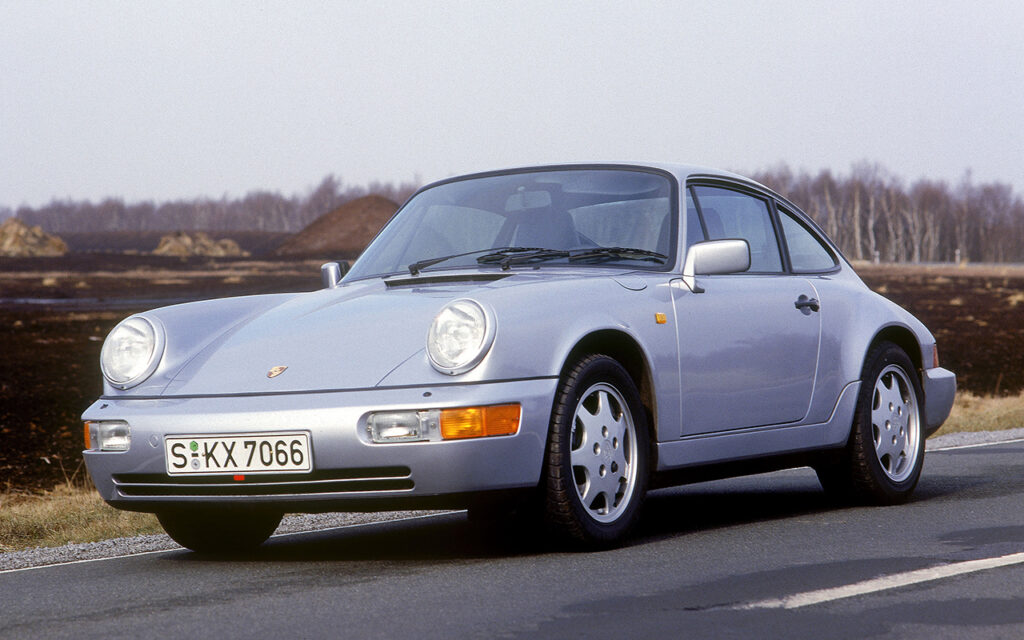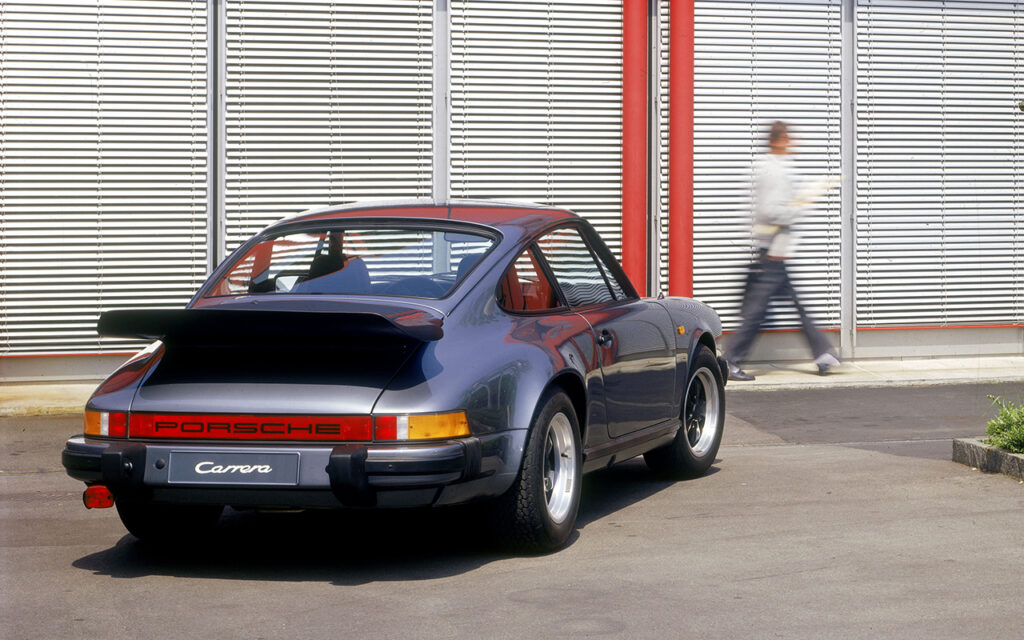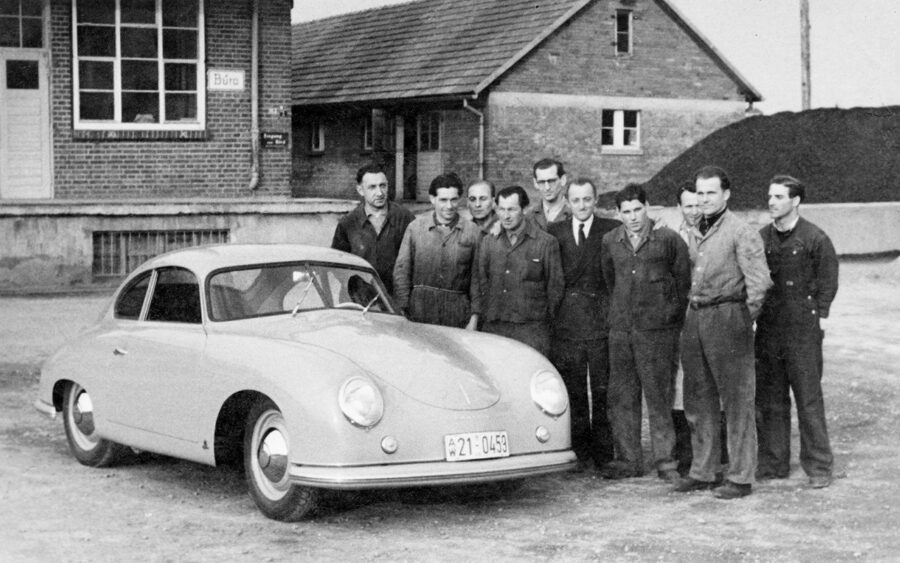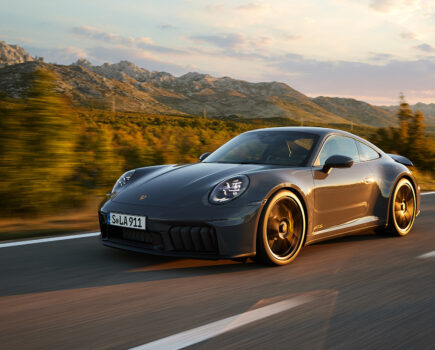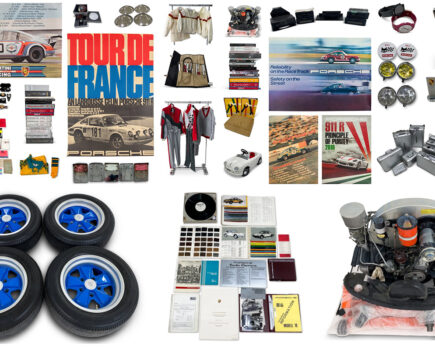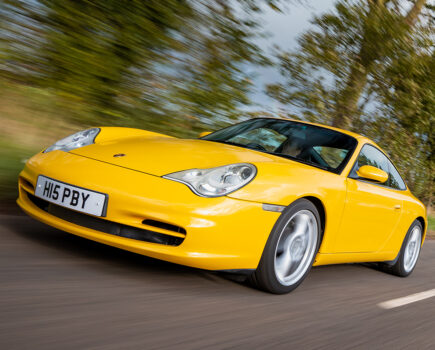Porsche has diversified in recent years but all its cars share the same sporting gene, synonymous with the company since its inception over 70 years ago
Words: Richard Gooding
Many enthusiasts believe the Porsche 911 to be the definitive sports- or classic car, and it’s certainly the most recognisable model from the Stuttgart marque. However, a procession of varied models have book-ended the iconic sports coupé, with engines in the front, rear and middle.
Company founder Ferdinand Porsche is probably most well-known for designing the motoring icon that is the Volkswagen Beetle in the 1930s, as a car intended to give mobility for the masses. A streamlined motorsport-influenced coupé based on Beetle mechanicals and designated the Type 64 could be considered the first step towards Porsche being the entity it is today.
1940s
Porsche’s first production model was the 356, launched in 1948. Creating the Porsche brand itself, the ‘VW Sport’ or ‘Type 356’ – the 356th project Porsche senior had worked on – was a small, two-door rear-engined coupé and convertible. The personal project of Ferdinand Porsche’s son, Ferdinand ‘Ferry’ Porsche, the car pilfered parts from the Beetle, including its 1,086cc engine.
Styled by Beetle designer Erwin Komenda, the 356’s softly-curved appearance captured many hearts straight away. The pretty sports coupé’s involving handling was a world away from the Volkswagen. Shortages of components in post-WWII Germany dictated the parts sharing, Ferry signing an agreement with VW’s Heinz Nordhoff allowing Porsche to use Beetle bits and the Wolfsburg firm’s sales and service network. Little did either party realise, this deal would be the foundation for future tie-ups – and Volkswagen’s eventual ownership of Porsche.
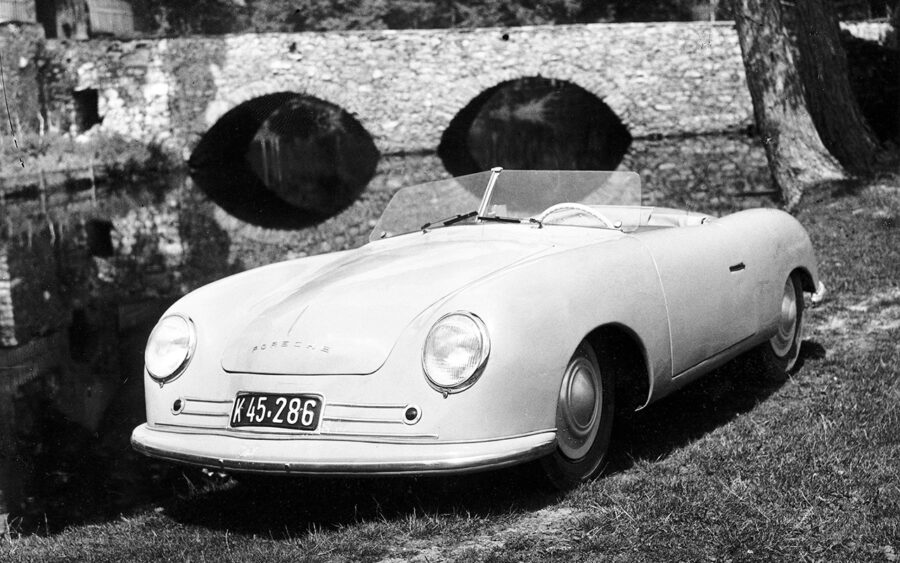
Power was lifted to twice that of the Volkswagen, the open-top 356-001 and closed coupé 356-002 prototypes paving the way for Porsche’s first properly desirable car. The 40bhp 356 boasted a winning combination of comfort and reliability. Most of all, it had the sports car agility for which Porsche has become famous for.
Ferry Porsche and his sister Louise Piëch established Dr Ing h c F Porsche GmbH in 1948, and hand-made production of the first 52 examples of the 356 – named 356/2, identifiable by their split windscreens – started a year later at the company’s office based in a sawmill in Gmünd, Austria. The car quickly gained notoriety from enthusiasts, and demand was such that production shifted to a leased space in the Reutter Karosserie coachworks factory in Zuffenhausen – Porsche’s current home – near Stuttgart in 1950.
1950s
Just before a power bump to 60bhp in 1951, Porsche took the 356 racing. The brand’s first appearance at Le Mans saw a trio of 45bhp aluminum 356 SL ‘Super Light’ coupés sent, and although only one car finished, it won the 1100cc class and came 20th overall. Since then, Porsche has enjoyed 19 overall victories and 108 class victories at the French circuit. Spurred on by the 356’s French success, an eighth place finish in the Mexican Carrera Panamericana road race in 1952 brought an everlasting motorsport-inspired name association.
Porsche developed its first bespoke racer, the 550 Spyder, in 1953. Using the same recipe as that original mid-engined 356-001, the lightweight 550kg machine married an aluminium body to a flat-welded steel tubular frame. Its 1.5-litre, 108bhp, four-cylinder, four-cam ‘Type 47’ air-cooled engine developed 108bhp. Success was immediate, the car winning its first outing at the 1953 Nürburgring Eifel Race, while other victories came at the Carrera Panamericana, Le Mans and Mille Miglia. Of the 90 550 Spyders built, arguably the most famous is chassis number 550-0055, otherwise known as the ‘Little Bastard’ in which James Dean died in 1955.
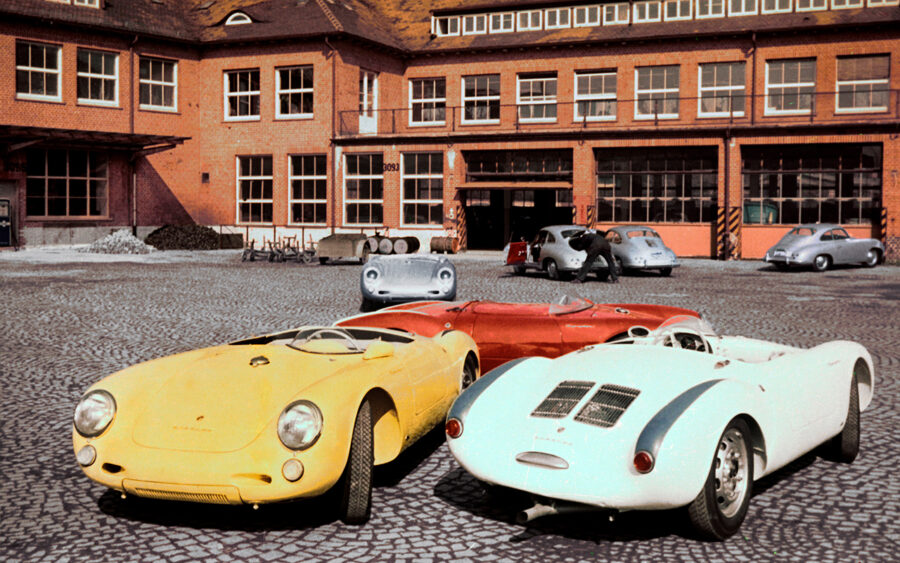
Away from the tracks, the 356’s potential was still untapped. US sports car impresario and Porsche importer Max Hoffman clamoured for a cheaper 356 in Porsche’s racing image. The 356 Speedster was most noticeable by its cut-down – and removable – windscreen, and the ‘Speedster’ legend on its front wings. An instant hit, it was beloved by weekend racers in Southern California.
The introduction of the 100bhp, four-cam, 1500 GS Carrera propelled the 356 to true classic car deity status. Built with an eye on competition, with essentially the same engine as the 550 Spyder, the tiny car could hit 120mph. The 356’s competition career continued into the 1960s, competing in the Nürburgring 1,000km race, Le Mans and the Targa Florio.
Major upgrades in 1956 (356 A), 1960 (356 B) and 1963 (356 C) kept Porsche’s first production model alive for almost 18 years, the car giving rise to the birth of the 911 in 1963; the same year Porsche took over Reutter and relocated to Zuffenhausen permanently.
1960s
Planning for what would become Porsche’s most celebrated model began in 1957. The 356 was beginning to lag behind the competition, and although a new product was needed, it was decreed it should share the same rear-engined layout and gently curvaceous appearance as its predecessor. Ferry Porsche’s son, Ferdinand Alexander ‘Butzi’ Porsche penned the new car’s looks. Christened ‘901’, this was changed to 911, after it was pointed out that Peugeot owned the rights to cars with ‘0’ in the middle of their three-digit number names.
The new 2.0-litre 128bhp 911’s engine was designed by Hans Mezger. Later 160bhp 911 S and 110bhp 911 T (‘Touring’) models were joined by a semi-open roof 911 Targa, noticeable by its roll-over hoop and zip-off rear window. Later glass rear window models followed, and named after the Targa Florio race, the semi-open 911 has been a favourite ever since. As the 911 ventured upmarket, it inevitably cost more, so a four-cylinder 912 model was introduced, mating the 356’s engine with the 911’s body.
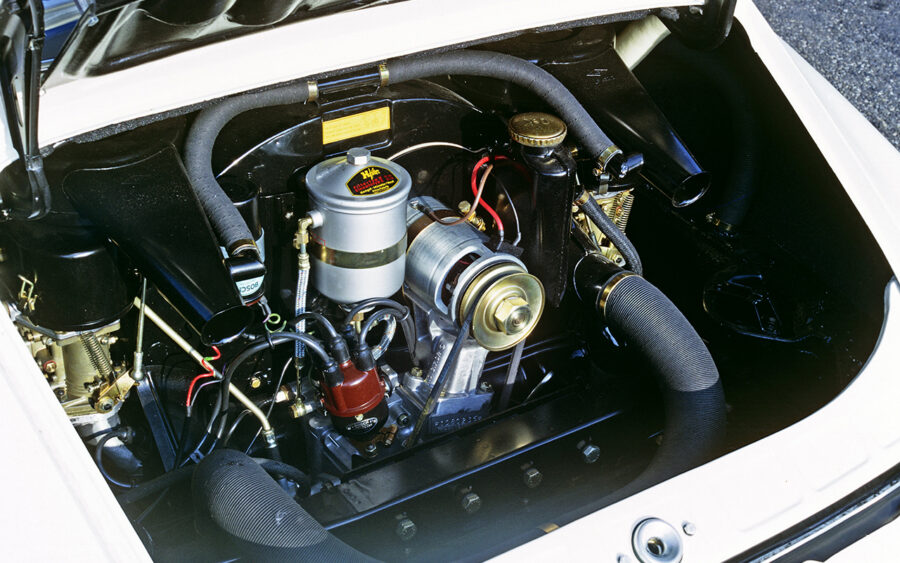
‘Butzi’ also developed Porsche’s first car with a plastic body. The 904 Carrera GTS could be powered with a range of engines, from four to eight cylinders. In eight-cylinder form, the 2.0-litre 904 developed 237bhp, and just five months after its debut in 1964, it won the Targa Florio. Success also came in the Monte Carlo Rally as well as the Le Mans 24 Hours. It was followed by the 906 Carrera 6, 907-series, 908-series, 909 and 910-series of race cars.
With a formidable taste for motorsport, the Formula 2 and Formula 1 Word Championships also came calling for Porsche participation. Open-wheeled versions of the 718 racer carried Porsche’s F2 ambitions, but the greater-focused 804 was a much more serious proposition. The car was competitive during the 1962 season but nothing more, and the investment versus results equation didn’t add up.
Porsche pulled the plug on its F1 constructor dreams, but did re-enter the top-flight arena in the 1980s as the official engine supplier for TAG McLaren F1’s machines, dominating the series for three consecutive seasons.
The 912 re-introduced the concept of an affordable Porsche, something which the company re-visited with the 914 of 1969. Developed with Volkswagen, there were parallels with the 356, but the mid-engined VW-Porsche took its layout inspiration from motorsport. Powered by an 80bhp flat-four from Volkswagen’s 411E, performance of the 914/4 was adequate, but nothing more. The anté was upped with the 110bhp six-cylinder 914/6 but with a price encroaching on the 911’s, it only lasted two years. Subsequent updates included 1.8-litre 85bhp and 100bhp 2.0-litre versions, and with 118,962 examples of both four and six-cylinder models built before the car’s demise in 1976, it was considered a moderate success.
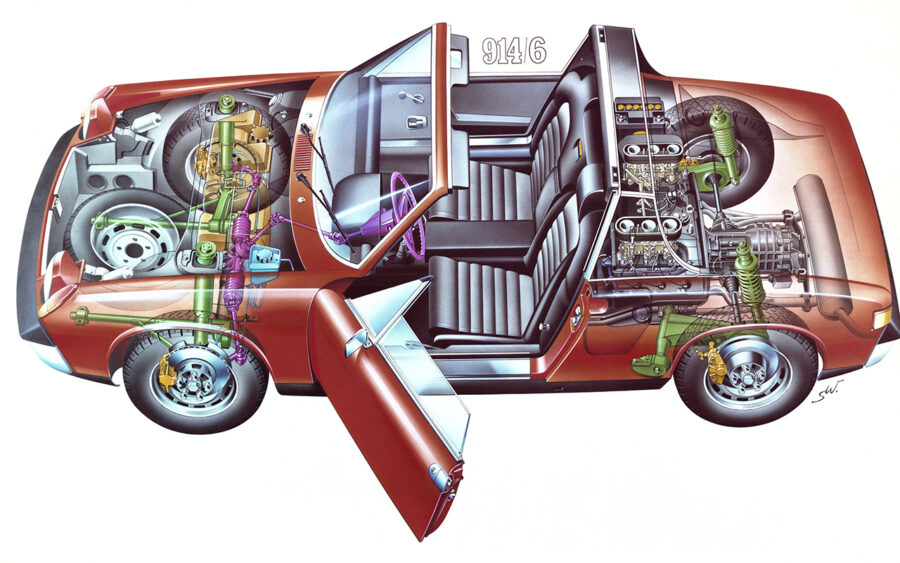
One key man involved in the 914’s conception was Ferdinand Piech, grandson of Ferdinand Porsche. Future chairman of the Volkswagen Group, Piech was also vital in the creation of another Porsche legend. The 917 was conceived to compete in the 1960s World Sportscar Championship, its 4.5-litre, 12-cylinder air-cooled engine making 552bhp with a lightweight body made from fibreglass-reinforced plastic resin, fixed to an aluminium lattice frame. Its most celebrated win came at the 1970 Le Mans 24 Hour race. Rule changes in 1973 meant competition switched to the US, and the addition of turbocharging saw power of 1,183bhp. The car dominated the CanAm series and was the first in a long line of Porsche super-racers that included the 1970s’ 936, the 1980s’ 956 and 962, and the 2010s’ 919 Hybrid.
1970s
Porsche’s motorsport success inspired much of its activity in the 1970s. The 911 Carrera RS 2.7 of 1973 was the first in a line of race-tuned 911s, its 207bhp, 2.7-litre engine propelling it to 62mph in 5.8 seconds. Characterised by a ‘ducktail’ rear spoiler, Fuchs alloy wheels and a ‘Carrera’ script down each side, stripped out and ‘Touring’ versions were available. The harder-edged Carrera RSR won the Targa Florio in 1973, and by adding a turbocharger, Porsche claimed second place at Le Mans in 1974 with the 911 Carrera RSR Turbo 2.1. Later 911-based 934 and 935 racers continued this success.
The first turbocharged 911 road car, developed under the ‘Type 930’ designation, the 3.0-litre 930 Turbo of 1975 packed a 256bhp punch. Using braking systems and aerodynamics taken from motorsport – particularly the ‘whale-tail’ rear wing – the 930 Turbo did 0-62 in just 5.2 seconds. Other notable 1970s changes to the 911 included the arrival of the G-series cars with impact bumpers in 1973. Of these, the naturally-aspirated 911 SC was one of the more desirable.
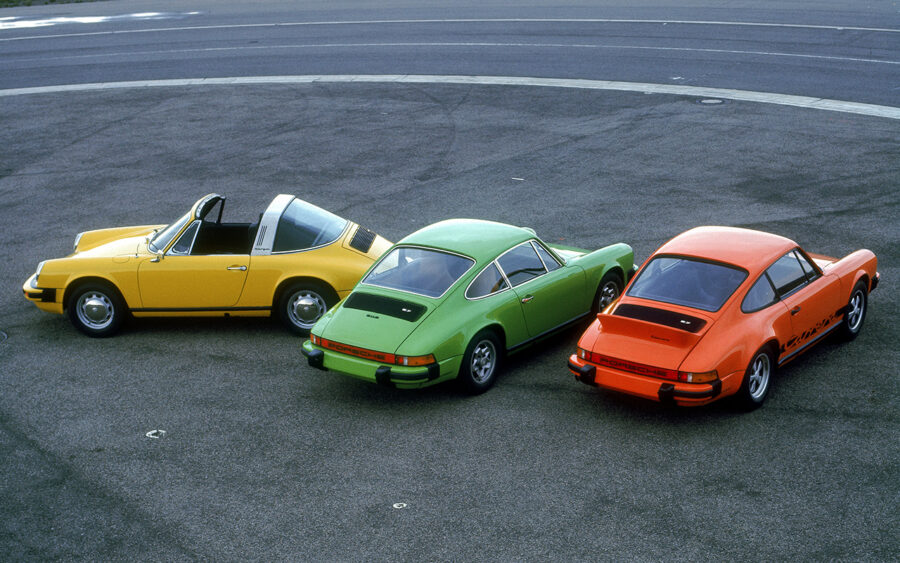
Porsche still held a contract to develop Volkswagen products, and in 1972, work on project ‘EA 425’ began. The flagship coupé would sit atop VW’s family of models, and so it had a very un-Porsche like silhouette. With the transaxle 928 of 1977 already in development, it inspired Porsche engineers to adapt the layout for the new VW. Slated for a 1976 launch, the oil crisis of 1973 gave Volkswagen cold feet and it pulled out of the project.
Porsche bought back the design and launched it in 1975 as the 924, powered by a 2.0-litre water-cooled engine which sent 125bhp to the rear wheels. European cars did 0-62mph in 10.5 seconds, topping out at 125mph. Building on the turbocharged 911’s success, the 170bhp 924 Turbo arrived in 1978, followed by the 1979 blistered-arch 924 Carrera GT prototype, developed to go racing at Le Mans. In 1980, the highest-placed 320bhp 924 Carrera GTP finished sixth.
With a dated layout, cramped rear seats and technical limitations from its mechanicals, high-ups at Zuffenhausen felt that the 911 had run its course and a ‘2+2’ grand tourer which could gobble continents was envisaged. While the 928 didn’t replace the 911, it was a technological marvel that proved to the world Porsche could innovate with the best of them. Visible pop-up headlamps aided aerodynamic efficiency, and integrated polyurethane bumpers and aluminium body panels reduced weight.
Motive power came by way of a 240bhp water-cooled, 4.5-litre V8, while the crowning glory was the car’s ‘Weissach’ axle. Specially developed for the 928, the rear-wheel steering system was designed to eliminate lift-off oversteer, by adjusting the rear suspension during cornering. Awarded ‘European Car of the Year’ in 1978, purists weren’t happy, but Porsche pushed on, the 4.7-litre, 300bhp 928 S taking things up a notch further.
1980s
The 1980s would see Porsche capitalise on the changes it made in the 1970s. Porsche reheated the 924 recipe for 1982’s 944. Porsche junked the 924’s VW-Audi-derived unit, installing its own 163bhp, 2.5-litre, four-cylinder motor. A more luxurious offering, just like the 924, it became the fastest-selling Porsche ever produced, saving the company’s bacon. Powerful S, Turbo, and Turbo S models took the car more upmarket.
Porsche chief Ernst Furhmann’s plans to ramp down production and kill the 911 were binned with new president and CEO Peter W Schutz. Diversification was key. The first 911 Cabriolet appeared in 1982 – a core staple of the 911 family ever since – and the 911 3.2 Carrera was ushered in.
Much was changed. Porsche claimed the 231bhp 3.2-litre engine was 80 per cent new, with 0-60 done in 6.1 seconds and a top speed of 152mph. A ‘Turbo-Look’ body kit, consisted of a ‘whale-tail’ rear wing and wraparound front spoiler, cementing the Carrera 3.2 as the poster car for a generation of Porsche enthusiasts.
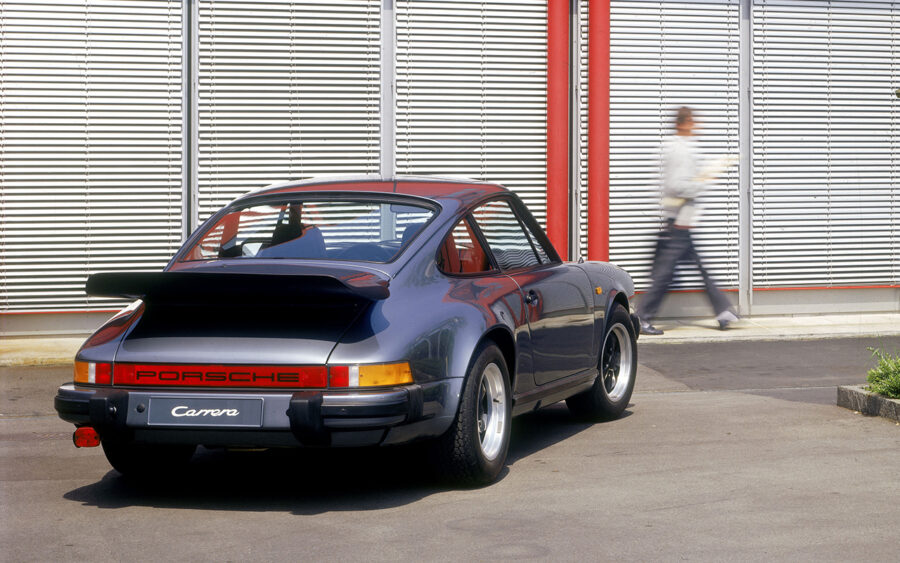
Following the victory of the four-wheel-drive rallying 911 that tackled the 1984 Paris-Dakar event, Porsche turned its attention to creating a new machine for the Group B rallying class. The 1983 Gruppe B concept clearly had 911 ancestry, but with aerodynamically enhanced bodywork made from aluminium, amaride-fibre plastic, Kevlar composite and Nomex, and a rear hoop spoiler.
Christened 959, the production car arrived in 1987. Technical highlights included a 2.5-litre flat-six with a pair of sequential turbochargers, an adjustable four-wheel-drive system, an automatic variable ride-height system and a six-speed gearbox. ABS also featured along with a tyre-pressure monitoring system built into the 17-inch magnesium alloy wheels. The 450bhp missile took the fight to the F40 and was Porsche’s most technologically advanced car ever; the über-Porsche’s top speed was 197mph, making it the fastest production car in the world.
1990s
Porsche experienced falling sales figures at the start of the 1990s, introducing lean production measures to stave off a takeover, but a sharp refocus was needed. A final update in 1991 saw the 944 changed so much that it got a new name: 968. The most celebrated version, the Club Sport of 1992, borrowed its name from more extreme earlier Porsche models to offer a purer driving experience.
Updated in 1988 for the 1990s, the 964-series 911 built on technologies seen with the 959. Four-wheel drive was a 911 first, and polyurethane bumpers and a retractable rear spoiler were distinctive features. The Carrera 4’s 3.6-litre engine pushed out 250bhp, performance put down by a new coil-spring suspension system, ABS and power steering.
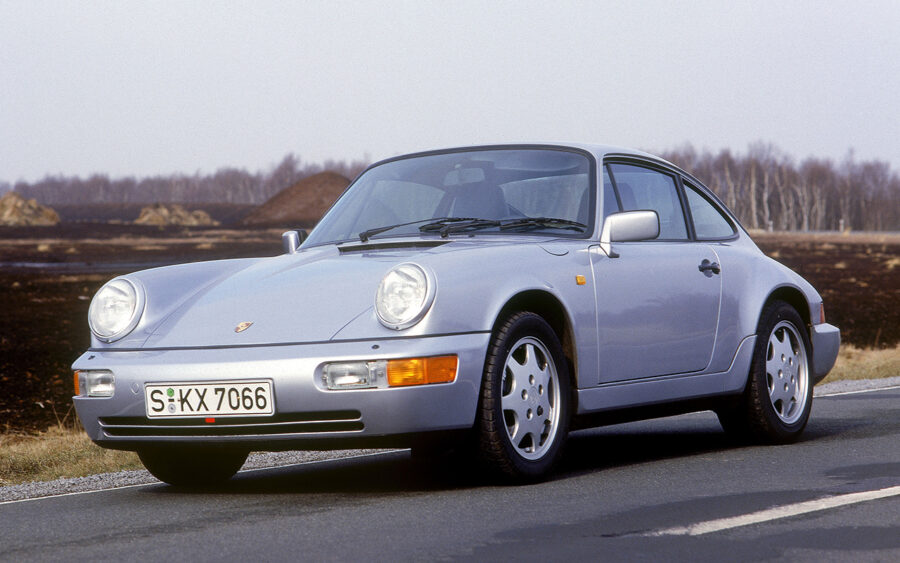
The 320bhp 911 Turbo topped the range, but hardcore drivers were truly rewarded with the 257bhp 911 Carrera RS. Channeling the spirit of the Carrera RS 2.7, the lightweight 964 had no rear seats, thinner glass, interior pull-straps, a strut brace and a limited-slip differential. Now the basis of luxurious retromods, the 964 was an important step to move the 911’s story forward.
Influenced by the wild-looks of the 964-based ‘Panamericana’ concept car, the 993-series 911 was the next chapter. The ‘Typ 993’ was the embodiment of everything Porsche had learned from its three-decade development of the 911. Building on the aerodynamic looks of the 964, the updated body masked radically-altered mechanicals with new aluminium multi-link rear suspension mounted on a subframe. The 408bhp 993 Turbo topped out at 180mph, making it Porsche’s fastest-ever production car, as well as the first 911 Turbo to gain all-wheel drive. 993 Carrera RS, Carrera 4, and race-spec RSR and GT2 models continued the line, but the essence of the 911 was about to change forever.
The 996-series 911 debuted in 1997, and shook purists to the core. Forced to re-evaluate the air-cooled engines due to impending emissions legislation, Porsche introduced a new series of water-cooled six-cylinder units. The most radical re-working of the 911 since its inception, the 996’s smooth shape and ‘fried-egg’ headlights were as controversial as its powerplants. Entry-level Carreras packed 296bhp, while with an engine derived from the Le Mans-winning 911 GT1, the 355bhp 911 GT3 brought race-bred thrills. The 996 was the last 911 generation observed by Ferry Porsche – the Porsche patriarch died on 27 March 1998.
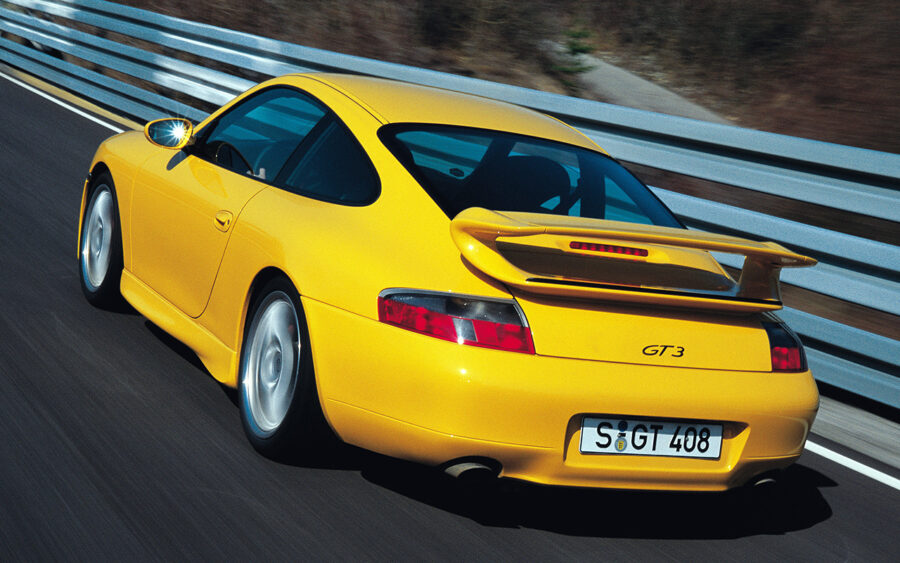
As the 911 moved upmarket, so did its price. A new entry level car was needed, and inspired by its heritage, Porsche knew where to look. The two-seat, mid-engined 986 Boxster roadster was trailed by a concept in 1993, and was an immediate hit on its launch in 1996, with half of Porsche’s 32,000 sales being that of its new open-top.
Recalling the 914 and 550 Spyder, the 2.5-litre, 204bhp Boxster shared components – most noticeably its front end – with the 996. Joined by a 252bhp Boxster S model, the car was quite literally a life-saver for the company, its part in turning around Porsche fortunes not to be underestimated.
2000s
Starting the millennium with a bang, Porsche pulled the covers off the sensational Carrera GT concept car in September 2000. A two-seat sports machine, it put the ‘super’ in supercar, with a screaming 603bhp V10 engine, a 205mph top speed, low-slung looks and a carbon-fibre body. Derived from a ditched Le Mans prototype racer project, 1,270 examples of the ‘Type 980’ were built.
It was business as usual for the 911, with evolutions and the addition of new models including the 414bhp Turbo, 443bhp Turbo S and 455bhp race-derived GT2. 2004 brought about a new generation 911, the 997. Bringing back the round headlights seen on past 911s, while the 997 was developed from the ashes of the 996, it was far from a facelift.

Enlarged 3.8-litre engines debuted along with Porsche Active Suspension Management (PASM), the first time electronic springs and dampers had been offered since the 959. The 473bhp 997 Turbo’s twin-turbo engine ushered in Variable Turbine Geometry and ‘phase 2’ ‘997.2’s brought in the Porsche Doppelkupplung (PDK) double-clutch transmission. The 4.0-litre 911 GT3 RS 4.0 was the 997’s crowning glory, having the biggest largest engine to ever grace a road-legal 911.
If the Boxster took Porsche in a new direction in the 1990s, two models would help it explore new markets in the 2000s. The Cayenne SUV of 2002 and the Panamera of 2009 both shared Volkswagen-derived platforms, and were as far away from the image of Porsche as it was possible to get. The 335bhp, 4.8-litre V8 Cayenne S was the entry level SUV, the 444bhp twin-turbo Cayenne Turbo the range-topper. Despite initial outcry that Porsche dared build an SUV – albeit a luxury one – it set the template for other sports SUVs and was a welcome sales success, even outselling the 911 in the 2007/2008 financial year.
Dabbling with four-door concepts in the past, it wasn’t until the arrival of the Panamera that Porsche got to grips with a luxury saloon. The grand tourer was reminiscent of a larger 911 in style, and, despite enthusiasts’ initial scepticism, was a pure Porsche – the Panamera Turbo could accelerate to 62mph from rest in just 4.2 seconds, with a top speed of 188mph. Another newcomer, the Cayman, was a closed coupé version of the second-generation 987 Boxster, plugging the gap between Boxster and 911.
2010s to present day
A full decade into the new millennium, and thoughts turned to saving the climate. The rise of hybrid and electrified vehicles was crucial to ease emissions, and Porsche embraced the technology with S Hybrid versions of the Cayenne and Panamera. A plug-in hybrid Cayenne debuted in 2013 and was the first premium SUV to feature such a powertrain.
Still very much rooted in combustion engine heritage, the 911 underwent another model change to become the 991 series – then the 992 series in 2018. Winding the looks of the 997 back even further to 911s of the past, the new car’s longer wheelbase gave more interior space, while its direct fuel injection engines were almost 12 per cent more efficient. The high-performance 468bhp 991 GT3 boasted rear-wheel steering and a specially tuned PDK transmission.
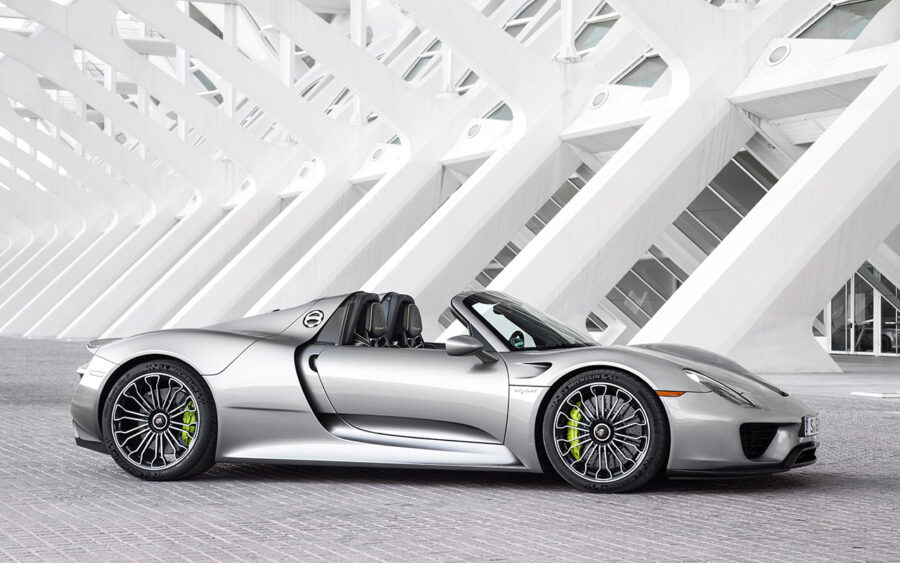
Boxster and Cayman models were updated, too, the new 981 series cars featuring more lightweight construction. A nomenclature change saw the number ‘718’ adopted by the Boxster and Cayman, referencing the models’ 718 RS 60 Spyder racing ancestor of the 1960s.
Electrification wasn’t just limited to family friendly Porsches, the 918 Spyder of 2014 bringing the emission-saving powertrain to a supercar format. In the mould of the Carrera GT, and combining a 600bhp, 4.6-litre eight-cylinder engine with a pair of electric motors, the stunning two-seater promised 874bhp and 85mpg. Production was limited to 918 units.
Continuing its adventure into new markets, the Macan SUV appeared in 2013. Smaller than the Cayenne, and with a more accessible price to boot, the Macan echoed the bigger Cayenne’s success, taking over a quarter of Porsche’s annual production of 187,208 cars in 2014.
The biggest hint to Porsche’s (and the car industry’s) future came in 2015, with the unveiling of the Mission E concept. A pure electric car, the 591bhp concept could accelerate to 62mph in just 3.5 seconds, capable of travelling over 310 miles on a single charge thanks to a world-first 800V drive system. Compatible with fast battery charging or wireless induction charging, the production model appeared in 2019, labelled Taycan. The most powerful 751bhp Taycan Turbo S was a typical Porsche when it came to performance: 0 to 62 was done in only 2.8 seconds.
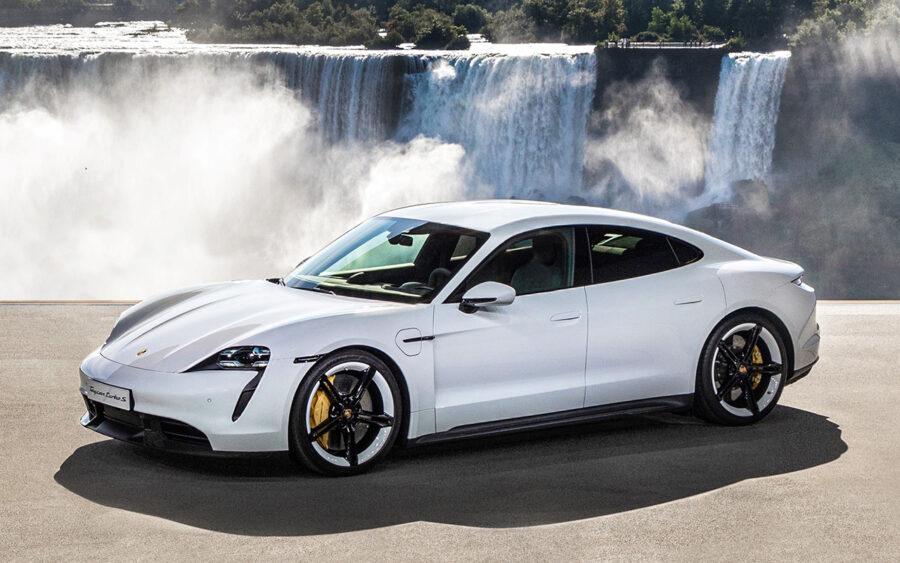
Buyers who didn’t appreciate the saloon layout of the Taycan could opt for the Taycan Sport Turismo or Taycan Cross Turismo, which embraced a ‘shooting brake’ estate-like rear end for an increase in practicality. The second-generation Panamera introduced a similar model in the Panamera Sport Turismo.
With electrification of its models clearly underway, Porsche looks set to carry on evolving and producing luxurious and more hardcore sports cars. Long a constant innovator, the engineers at Zuffenhausen will, no doubt, find new and exciting ways to tickle our performance car taste buds, whatever powertrains provide the motive power.
